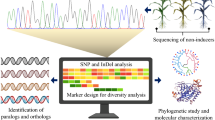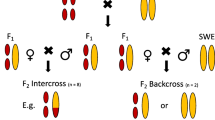Abstract
Triploidy has generally been considered to be an evolutionary dead end due to problems of chromosomal pairing and segregation during meiosis. Thus, the formation of tetraploids and diploids from triploid types is a rare phenomenon. In the present study, we demonstrated that inbreeding of the triploid planarian Dugesia ryukyuensis resulted in both diploid and triploid offspring in nature. In the triploids of D. ryukyuensis, chiasmata between homologous chromosomes were observed in both female and male germ lines. This result suggests that both diploid and triploid offspring of this species are produced bisexually by zygotic fusion between sperm and eggs. Hence, this phenomenon may be a novel mechanism in planarian for escaping the triploid state.





Similar content being viewed by others
References
Agata K, Watanabe K (1999) Molecular and cellular aspects of planarian regeneration. Semin in Cell Dev Biol 10:377–383
Baguñà J, Saló E, Romero R, Garcia-Fernàndez J, Bueno D, Muñoz-Marmol AM, Bayascas-Ramirez JR, Casali A (1994) Regeneration and pattern formation in planarians: cells, molecules and genes. Zool Sci 11:781–795
Bell G (1982) The masterpiece of nature: the evolution and genetics of sexuality. Univ. Calif. Press, Berkeley
Benazzi LG (1966a) Amphimixis and pseudogamy in freshwater triclads: experimental reconstitution of polyploid pseudogamic biotypes. Chromosoma 20:1–14
Benazzi M (1966b) Considerations on the neoblasts of planarians on the basis of certain karyological evidence. Chromosoma 19:14–27
Benazzi LG (1970) Gametogenesis and egg fertilization in planarians. Int Rev Cytol 27:101–179
Benazzi LG (1971) On the cytological mechanism of pseudogamy in synaptic diploid hybrids of the planarian Dugesia lugubris. Rend Acc Naz Lincei Ser VIII 50:362–369
Benazzi M (1974) Fissioning in planarians from a genetic standpoint. In: Riser NW, Morse MP (eds) Biology of the Turbellaria. McGraw-Hill, New York, pp 476–492
Benazzi M, Benazzi LG (1976) Platyhelminthes. In: Bernard J (ed) Animal cytogenetics Gebrüder Borntraeger, Berlin–Stuttgart, pp 1–182
Beukeboom LW, Vrijenhoek RC (1998) Evolutionary genetics and ecology of sperm-dependent parthenogenesis. J Evol Biol 11:755–782
Beukeboom LW, Weinzierl RP, Reed KM, Michiels NK (1996) Distribution and origin of chromosomal races in the freshwater planarian Dugesia polychroa (Turbellaria: Tricladida). Hereditas 124:7–15
Curtis WC (1902) The life history, the normal fission and the reproductive organs of Planaria maculata. Proc Boston Soc Nat Hist 30:515–559
D’Souza TG, Storhas M, Schulenburg H, Beukeboom LW, Michiels NK (2004) Occasional sex in an ‘asexual’ polyploidy hermaphrodite. Proc R Soc Lond B 271:1001–1007
D’Souza TG, Storhas M, Michiels NK (2005) The effect of ploidy level on fitness in parthenogenetic flatworms. Biol J Linn Soc 85:191–198
D’Souza TG, Schulte RD, Schulenburg H, Michiels NK (2006) Paternal inheritance in parthenogenetic forms of the planarian Schmidtea polychroa. Heredity 97:97–101
Grasso M, Benazzi M (1973) Genetic and physiologic control of fissioning and sexuality in planarians. J Embryol exp Morph 30:317–328
Gremigni V, Miceli C, Picano E (1980a) On the role of germ cells in planarian regeneration. I. A karyological investigation. J Embryol Exp Morphol 55:53–63
Gremigni V, Miceli C, Picano E (1980b) On the role of germ cells in planarian regeneration. II. Cytophotometric analysis of the nuclear Feulgen-DNA content in cells of regenerated somatic tissues. J Embryol Exp Morphol 55:65–76
Gremigni V, Miceli C, Picano E (1982) Evidence of male germ cell redifferentiation into female germ cells in planarian regeneration. J Embryol Exp Morphol 70:29–36
Hoshi M, Kobayashi K, Arioka S, Hase S, Matsumoto M (2003) Switching from asexual to sexual reproduction in the planarian Dugesia ryukyuensis. Integ Comp Biol 43:242–246
Kawakatsu M, Oki I, Tamura S, Sugino H (1976) Studies on the morphology, karyology and taxonomy of the Japanese freshwater planarian Dugesia japonica Ichikawa et Kawakatsu, with a description of a new subspecies, Dugesia japonica ryukyuensis subspec. Bull Fuji Women’s College 23:127–132 Ser II
Kawakatsu M, Oki I, Tamura S (1995) Taxonomy and geographical distribution of Dugesia japonica and D. ryukyuensis in the Far East. Hydrobiologia 305:55–61
Kenk R (1937) Sexual and asexual reproduction in Euplanaria tigrina (Girard). Biol Bull 73:280–294
Kobayashi K, Hoshi M (2002) Switching from asexual to sexual reproduction in the planarian Dugesia ryukyuensis: change of the fissiparous capacity along with the sexualizing process. Zool Sci 19:661–666
Kobayashi K, Koyanagi R, Matsumoto M, Cabrera JP, Hoshi M (1999) Switching from asexual to sexual reproduction in the planarian Dugesia ryukyuensis: Bioassay system and basic description of sexualizing process. Zool Sci 16:291–298
Mable BK (2004) ‘Why polyploidy is rarer in animals than in plants’: myths and mechanisms. Biol J Linn Soc 82:453–466
Matsuda Y, Chapman VM (1995) Application of fluorescence in situ hybridization in genome analysis of the mouse. Electrophoresis 16:261–272
Menken SBJ, Smit E, Den Nijs HCM (1995) Genetical population structure in plants: gene flow between diploid sexual and triploid asexual dandelions (Taraxacum section Ruderalia). Evolution 49:1108–1118
Oki I, Tamura S, Yamayoshi T, Kawakatsu M (1981) Karyological and taxonomic studies of Dugesia japonica Ichikawa et Kawakatsu in the Far East. Hydrobiologia 84:53–68
Orr HA (1990) “Why polyploidy is rarer in animals than in plants” revisited. Am Nat 136:759–770
Otto SP, Whitton J (2000) Polyploid incidence and evolution. Annu Rev Genet 34:401–437
Ramsey J, Schemske DW (1999) Pathways, mechanisms, and rates of polyploid formation in flowering plants. Annu Rev Ecol Syst 29:467–501
Sakurai T (1981) Sexual induction by feeding in an asexual strain of the freshwater planarian, Dugesia japonica japonica. Annot Zool Jap 54:103–112
Stebbins GL (1938) Cytological characteristics associated with the different growth habits in the dicotyledons. Am J Bot 25:189–198
Storhas M, Weinzierl RP, Michiels NK (2000) Paternal sex in parthenogenetic planarians: a tool to investigate the accumulation of deleterious mutations. J Evol Biol 13:1–8
Stöck M, Lamatsc DK, Steinlein C, Epplen JT, Grosse W-R, Hock R, Klapperstück T, Lampert KP, Scheer U, Schmid M, Schartl M (2002) A bisexually reproducing all-triploid vertebrate. Nature genetics 30:325–328
Suzuki T, Kurosaki T, Shimada K, Kansaku N, Kuhnlein U, Zadworny D, Agata K, Hashimoto A, Koide M, Koike M, Takata M, Kuroiwa A, Minai S, Namikawa T, Matsuda Y (1999) Cytogenetic mapping of 31 functional genes on chicken chromosomes by direct R-banding FISH. Cytogenet Cell Genet 87:32–40
Tamura S, Oki I, Kawakatsu M (1991) Karyological and taxonomic studies of Dugesia japonica from the Southwest Islands of Japan—II. Hydrobiologia 227:157–162
Tamura S, Oki I, Kawakatsu M (1995) A review of chromosomal variation in Dugesia japonica and D. ryukyuensis in the Far East. Hydrobiologia 305:79–84
Tamura S, Yamamoto K, Takai M, Oki I, Kawakatsu M (1998) Karyology and biogeography of Dugesia japonica and Dugesia ryukyuensis in Kyushu, southern Japan. Hydrobiologia 383:321–327
Verduijn MH, Van Dijk PJ, Van Damme JMM (2004) The role of tetraploids in the sexual–asexual cycle in dandelions (Taraxacum). Heredity 93:390–398
Zietara MS, Kuusela J, Lumme J (2006) Escape from an evolutionary dead end: a triploid clone of Gyrodactylus salaris able to revert to sex and switch host (Platyhelminthes, Monogenea, Gyrodactylidae). Hereditas 143:84–90
Acknowledgements
We thank Dr. Shinichiro Nishitani and Dr. Takahiro Murakami for providing detailed information on chromosome preparation. We would also like to thank Dr. Thomas G. D’Souza for his valuable discussion and comments on this manuscript and Dr. Yutaka Tomita for his advice on the statistical analysis. This work was supported in part by a Grant-in-Aid for Scientific Research (No. 100082 and 16086209) from the Ministry of Science, Culture, Sports and Education, Japan (MH and MM) and from PRESTO, Japan Science and Technology Corporation (KK).
Author information
Authors and Affiliations
Corresponding author
Additional information
Communicated by E.A. Nigg
An Erratum for this chapter can be found at http://dx.doi.org/10.1007/s00412-008-0156-6
Rights and permissions
About this article
Cite this article
Kobayashi, K., Ishizu, H., Arioka, S. et al. Production of diploid and triploid offspring by inbreeding of the triploid planarian Dugesia ryukyuensis . Chromosoma 117, 289–296 (2008). https://doi.org/10.1007/s00412-008-0148-6
Received:
Revised:
Accepted:
Published:
Issue Date:
DOI: https://doi.org/10.1007/s00412-008-0148-6




